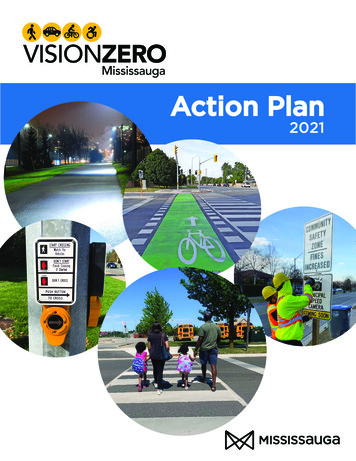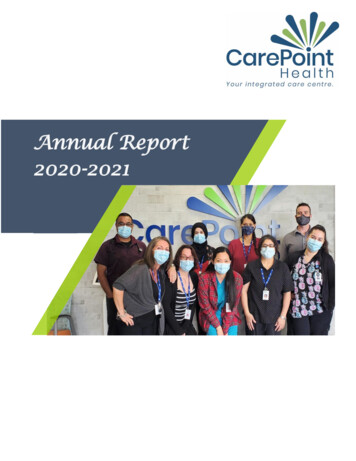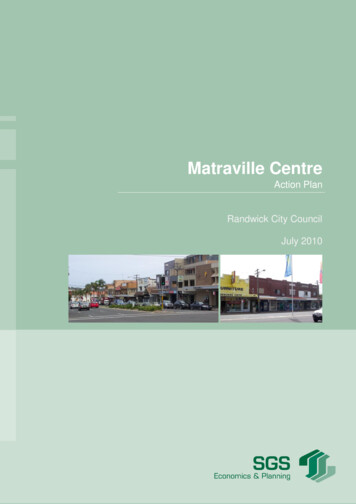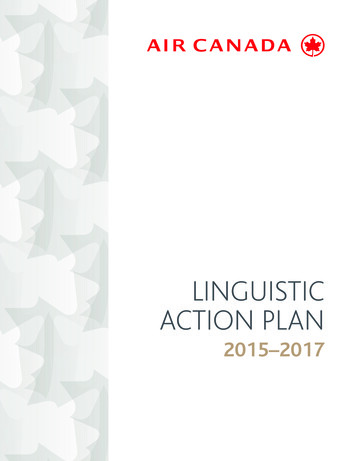
Transcription
Action Plan2021
IntroductionIn Mississauga, no loss of life on our roadways is acceptable. Ensuring the safety of all roadusers is critical when making decisions about developing and updating our transportationnetwork. The Vision Zero approach prioritizes safety for all road users by slowing speeds,educating people and enforcing laws to support safer behaviour on the roads. The VisionZero approach to road safety started in Sweden in 1997. Since then, it has been adopted bymany cities across the world, including Peel Region and Mississauga.VISION ZERO COMMITMENTIn 2018, the City of Mississauga officially committed to VisionZero through a Council-approved motion. That means citystaff and elected officials are working toward a goal of ZEROfatalities and serious injuries from collisions on city streets.0 FATALITIES0 SERIOUS INJURIESThe Vision Zero approach acknowledges that people make mistakes and that the transportationsystem needs to be designed and operated in a way that mitigates the negative impactsof human error. To do this, the Vision Zero approach relies on data-driven decision makingto provide a safe and equitable transportation network that protects all users, with specificemphasis on the most vulnerable users of our roads like pedestrians and cyclists.The City of Mississauga (“the City”) has developed this Vision Zero Action Plan to providecity staff with actions they can apply to their current and ongoing projects so that theycontribute to the Vision Zero goal of eliminating fatalities and serious injuries in ourtransportation system. The plan also consists of education and engagement actions that theCity can take to help inform residents about road safety and create transportation-relatedbehaviour change.1
Vision Zero efforts are categorized into the 5 “Es” of road safety:EvaluationTracking and monitoring incidents, learning from the past to improveconditions in the future.EngineeringPrioritizing the safety of pedestrians, cyclists, and other vulnerable userswhen designing and operating streets.EnforcementEnsuring there are consequences for breaking rules or taking unnecessaryrisks while travelling.EmpathyFostering concern for community members who are at risk or have beenharmed while travelling.EducationEnabling travellers to learn and follow best practices through road signs, socialmedia, formal training, and other creative outreach and education tactics.This plan presents actions for all 5 focus areas, with Education and Empathy combinedtogether. The 5 Es are of equal importance as efforts from all 5 are needed to improve roadsafety conditions in Mississauga. All recommended actions have been categorized underone primary focus area, but many actions are influenced by additional focus areas, whichare also highlighted throughout the document with the use of the icons identified above.Vision Zero Action Plan – 20212
Vision Zero in MississaugaThe City of Mississauga committed to Vision Zero in 2018 through a Council-approvedmotion. Mississauga City Council also passed a resolution to adopt Vision Zero and worktowards a goal of zero fatalities and serious injuries as a result of collisions on city streets.The City’s pledge to achieve Vision Zero was further strengthened through theTransportation Master Plan (TMP) approved in 2019. The TMP included 91 action itemsrelated to transportation improvements in the city. The TMP provided further direction toadvance Vision Zero work. This led to the development of this Vision Zero Action Plan.Data, Targets and EquityThe fundamentals of Vision Zero are based in data-driven decisions. The City of Mississauganeeds to analyze and assess available data through a Vision Zero lens to provide targeteddirection for many of the actions identified in this document. Analyzing available data todetermine trends, hot spots and areas of focus are key to a successful Vision Zero approach.Data-driven decisions also help achieve equity in road safety efforts. Projects are prioritizedbased on proven need rather than perceived need.Vision Zero principles and practices should be applied equitably throughout the city. Dataplays a key role in staff’s ability to be successful in this regard, by enabling a proactive (i.e.analysis and prioritization of needs) versus reactive (i.e. complaints-driven) approach.It is also important that staff understand the limits of the data currently available andlook for ways to supplement with other sources of data, including input gathered throughinclusive approaches to community engagement. There is evidence to suggest that oftencommunities most in need are also least likely to report collisions, injuries or other seriousconcerns. They may not have the same access to their local representatives, the sameamount of time to allocate to voicing their concerns and providing their input, or the beliefthat they will be heard to the same degree if they present an issue. Vision Zero efforts mustaccount for this and look for opportunities with equity at the forefront of decision making.A Vision Zero annual report to highlight progress with implementation of the recommendedaction items in this plan will be presented to Council. However, real change is best analyzedover multiple years. Without an appropriate baseline of data, setting a target for changeover time would be premature. Many of the action items that follow in the Evaluationsection will help determine the City’s baseline and appropriate targets for collisionreductions in Mississauga.3
About This PlanThis plan consists of 99 actions that are intended to help Mississauga reach its goal ofachieving zero fatal and serious injury collisions on the road network. City staff can use thisplan as a toolkit of possible actions that they can take in their work to protect vulnerableroad users.Many of the actions identified in the following tables are currently in progress or havealready been applied to city projects. Some actions will require further research andcoordination before they can be implemented within the city.The intention of this plan is to build upon the recommendations in other transportationrelated plans already approved by the City including the Cycling Master Plan, PedestrianMaster Plan and Transportation Demand Management Plan. The Vision Zero Action Planhas also been developed in coordination with forthcoming plans including the ChangingLanes Street Classification system and Complete Streets Guide. This plan expands upon therecommendations of the City’s Transportation Master Plan (TMP), and any links betweenTMP Actions and Vision Zero Actions are identified in the tables with this icon:TMPAcronyms & terms used in the action plan tablesThe following is a list of the acronyms used in the “Lead” column of the action plan onymVision Zero Program LeadVZVision Zero Working GroupVZWGInfrastructure Planning & EngineeringIPETraffic Management and Municipal ParkingTMMPWorks, Operations & MaintenanceWOMStrategic Communications and InitiativesSCIMiWayMWPlanning and BuildingPBThe following terms are used in the “Timeline” column:StatusDescriptionInitiatedStaff are in the process of completing this action already.Short1-2 yearsMedium3-5 yearsCurrentlyConsideredMany of the actions, particularly within the Engineering focus area have an indicatedtimeline of “Currently Considered” which refers to a change in staff practices thatshifts prioritization to safety of vulnerable road users. Many of these new optionshave been used already as part of some city projects or considered for upcomingroad-related projects. Many of the actions identified as “Currently Considered” areevaluated on a project-by-project basis for their applicability.Vision Zero Action Plan – 20214
EvaluationVision Zero is based on data-driven decision making that istransparent. The City needs to advance its data collection and analysisefforts in order to better inform decision making. Good quality,reliable data allows staff to be increasingly proactive to mitigatesafety concerns rather than reactive to incidents or neighbourhoodcomplaints.Below is a list of actions to improve the overall evaluation and datacollection related to road safety in Mississauga.EVALUATIONActionLeadTimelineOther RelevantAreas1Collision Report ProcessingProcure services to process annual collisionreports received from Peel Regional Policefor ease of tracking and evaluating.TMMPShortEngineering2Transportation Data PlanConduct a Transportation Data Studyto look at trends on the transportationnetwork, and guide planning and roadsafety decisions.TMMPShortEngineering/Education3Data Management ProgramEnhance existing management programfor the City’s collision and traffic data toinform future road safety initiatives. Exploreopportunities to obtain additional dataincluding near-miss collisions or those thatgo unreported.TMMPShortEngineering/Education4Online DashboardDevelop a digital dashboard of up-to-dateinformation about collision data and otherkey road safety statistics and metrics thatcan be publicly accessed.VZShortEducation5Vision Zero Digital MapDevelop a public map where all RoadSafety and Vision Zero projects (trafficcalming projects, slow street locations,engagement events, etc.) are displayed andcan be queried by different criteria.VZShortEducation5
6Road/Intersection AuditsDevelop an audit program for intersectionand road safety practices. Work with theRegion of Peel to standardize the auditsfor locations where regional roads and cityroads roject Follow UpImplement a post-project review for roadsafety-related education and infrastructureprojects to determine effectiveness inimproving safety for road users.AllMediumEducation8Collision ReviewDevelop a process to review completedcollision reports from serious and fatal injurycollisions occurring on Mississauga roadwaysto inform future road safety efforts.VZWGMediumEngineering/Education9Collision Reduction TargetUse data gathered through collision reportprocessing, traffic volume, speed data andother available data to set a target forcollision reduction in Mississauga.VZShort10Annual Report to CouncilReport back on Vision Zero efforts andprogress annually to Mississauga Council.VZShortEducationBefore and after evaluation of trafficcalming effectiveness – Action #7Vision Zero Action Plan – 20216
EngineeringMississauga’s road network was developed to move vehicle traffic asefficiently as possible. Over time, the city has evolved and urbanized,and the way people move has changed. Some of the biggestopportunities for behaviour change by all road users come fromaltering the physical built form of the transportation network. In aVision Zero city, the road network should be built to guide decisionsfor speed, crossing, turning and other movements. Change can bedifficult to adapt to, especially when it comes to speed reductions andperceived travel times, but as the needs of our residents change andsafety is prioritized, our road network must also adapt.ENGINEERING: DesignActionLeadTimeline11Lane WidthsImplement narrower lane widths wherepossible as a tool to improve speedcompliance, reduce crossing distances andaccommodate the needs of all road users.IPECurrentlyConsidered12Design SpeedThrough the Capital or developmentrelated design process or as part ofplanning and design for any street project,reduce the design speed for new andretrofit road projects.IPECurrentlyConsidered13Channelized Right Turn LanesAvoid channelized right turns at any newintersections within the city. Look foropportunities to remove and retrofit roadswith existing channelized right turns.IPECurrentlyConsidered14Auxiliary Turn LanesLimit the use of auxiliary turn lanes in newroad designs and seek to remove themwhere appropriate in redesign and retrofitprojects to shorten crossing distances forpedestrians and slow speeds.IPECurrentlyConsidered15Stop Bar LocationEvaluate the distance of vehicle stop barsfrom pedestrian crossings and crossrides toincrease visibility.TMMPCurrentlyConsideredOther RelevantAreas7
16RoundaboutsRoundabouts should be considered whereappropriate to reduce the severity ofcollisions and improve traffic flow whilemaintaining the safety of vulnerable roadusers. Ensure any new roundabout has arobust education campaign.IPECurrentlyConsidered17Protected and Dedicated CyclingInfrastructureContinue to implement the cycling networkapproved in the Mississauga Cycling MasterPlan. Where possible, strive for protectedand dedicated infrastructure.IPECurrentlyConsidered18Pedestrian Master Plan ImplementationContinue to implement therecommendations of the Pedestrian MasterPlan with particular focus on the actionsrelated to a safe and connected network ofpedestrian facilities.IPECurrentlyConsidered19Protected Pedestrian CrossingsPrioritize protected crossings forpedestrians based on the local context,specifically where pedestrian volumesare high and controlled crossings are notconvenient or accessible.TMMPIn Progress20Road Diets/ 2 1 RoadwaysExplore opportunities across the city totransition 4-lane roads to 2 1 configurationwhere the local characteristics support thisapproach in an effort to reduce conflictsand improve safety.TMMP/IPECurrentlyConsidered21Sightline ImprovementsMaintain sightlines at intersections anddriveways to improve driver visibility ofvulnerable road users. Do not place trees,street furniture, or bus stops (wherepossible) in locations that limit visibility.VZMedium22Centre Medians/Refuge IslandsWhere appropriate, use centre medians andrefuge islands as locations to provide fortwo-stage crossings.TMMP/IPECurrentlyConsidered23Crossing GuardsContinue the City’s crossing guard programand evaluate new locations with theassistance of Traffic Safety Council.TMMPInitiatedVision Zero Action Plan – 2021Education8
ENGINEERING: Retrofit/Reconstruction/Resurfacing24Posted Speed Limits/NeighbourhoodSpeeds ProjectContinue implementation of NeighbourhoodSpeeds Project to lower speed limits from50 km/h to 40 km/h on local roads andfrom 40 km/h to 30 km/h in school zones.Explore opportunities to change speedlimits on arterial and collector streets.TMMPInitiatedEducation/Empathy25School ZonesContinue to prioritize safety in schoolzones through engineering opportunitiesincluding traffic calming, lower speed limits,parking restrictions, mobile speed boards,pavement marking and any other affic CalmingContinue to implement the City’s existingtraffic calming portfolio. Implement trafficcalming solutions including raised crossings,speed cushions and raised intersections.TMMPInitiated27Coordination of Traffic CalmingOpportunities with Road ResurfacingEnsure coordination between traffic calmingopportunities, active transportationinfrastructure and road resurfacing programto optimize project budget and resources.TMMP/IPEInitiated28Long-Range Vulnerable Road User/TrafficCalming Infrastructure PlanningDevelop a long-range, data-driven trafficcalming and pedestrian cross over programto strategically address speeding andsafety challenges in neighbourhoods whereit is most needed.TMMPMediumEvaluation29Mobile Speed BoardsContinue to use mobile speed boardsacross the city as a tool for improvingspeed compliance. Rotate the City’s fleet ofboards to have greater impact city 9
30Mountable Truck/Bus ApronsIn locations that have high truck and bustraffic as well as significant pedestrian andcycling traffic, implement mountable truckaprons to allow large vehicles to navigateintersections safely while narrowing thetravel lanes and reducing the turning radiusfor standard vehicles.IPECurrentlyConsidered31Vehicle Access PointsMake an effort to limit the number ofdriveways and access points on Mississaugaroadways. Driveways create increasedconflict zones for all road users.IPECurrentlyConsidered32Pavement Markings/Urban Edge LinesWhere appropriate, use pavement markingsto narrow travel lanes in an effort to improvespeed compliance and lower travel speeds.Pavement markings can be used to alterturning radii and shorten crossing distances.TMMP/IPECurrentlyConsidered33On-Street ParkingUse on-street parking locations strategicallyto act as a speed management tool. Incontrast, ensure that on-street parkingrestrictions are in place where parkedvehicles may impact sightlines and safety.TMMPCurrentlyConsidered34All-Way Stop Policy ImplementationImplement the City’s new all-waystop policy to avoid the installation ofunwarranted all-way stops as a falsemeans for calming traffic and protectingvulnerable road users.TMMPInitiated35Vision Zero Staff WorkshopsHost bi-annual staff workshops tocoordinate upcoming roads projects andfind opportunities to prioritize Vision Zeroprojects and efforts.VZShortVision Zero Working GroupContinue regular meetings of theMississauga Vision Zero Working Group to36ensure coordination and actualization ofthe Vision Zero Action Plan and other VisionTMP Zero efforts.Vision Zero Action Plan – ducation andEmpathy10
37TMPPeel Region Vision Zero TaskforceCity of Mississauga will continue tocollaborate with regional partners throughthe Vision Zero Task Force coordinated byRegion of Peel Road Safety INEERING: MiWay/Transit38Transit Stop Rationalization AnalysisUndertake stop rationalization analysis todetermine the most suitable location fortransit stops while prioritizing safety ofpedestrians and cyclists.MWInitiated39Bus Stop InfrastructureContinue to implement bus stop infrastructuresuch as transit shelters that ensuresconnections to the existing and proposedpedestrian and cycling networks.MWCurrentlyConsidered40Mid-Block Bus StopsWhere possible avoid installation of newmid-block bus stop locations whereprotected crossings are not accessible.MWCurrentlyConsidered41Queue Jump LanesContinue to implement queue jump lanesfor transit vehicles where appropriate andensure safety for all modes is consideredduring location and design evaluations.MWCurrentlyConsidered42Red Plastic Pavement ApplicationUse red plastic pavement application toidentify bus bays and bus only lanes.MWCurrentlyConsideredEducation43Mixing ZonesMake efforts to reduce mixing zones ofvarious modes at bus stops. Where mixingzones are unavoidable due to constraintsin available right of way, spaces shall beclearly identified for all users.MWCurrentlyConsideredEducation11
ENGINEERING: Lighting44Street Lighting UpgradesPlan for and incorporate appropriate street,trail and sidewalk lighting upgrades intoplanning and design of ongoing and newcity projects.TMMPInitiated45Street Lighting at IntersectionsEnsure that street illumination at intersectionsacross the city provides a safe environmentand enhanced visibility for all road users.TMMPInitiated46Street Lighting Along Street CorridorEnsure that street lighting requirementsare identified through larger improvementprojects, where possible to align with theCity’s upgraded standard.TMMPCurrentlyConsidered47Review of Street Lighting StandardsReview the industry standard and updatecity policies and practices on street lightingin accordance with the standard.TMMPMedium48Lighting at Trail CrossingsLook for opportunities to increase visibilitywhere off-road trails intersect withroadways through enhanced lighting.TMMPShortENGINEERING: Signals49Infrastructure Quality and SynchronizationContinue to maintain and constructphysical infrastructure of signals consistentwith current practices. Ensure appropriatesynchronization to reduce driver frustration,improve traffic flow and ensure high levelsof safety.TMMPInitiated50Leading Pedestrian IntervalDetermine locations throughout the citywhere the Leading Pedestrian Interval canbe implemented to provide pedestrianswith the ‘Walk’ interval prior to the start ofthe green indications for motorists.TMMPShort51Exclusive Pedestrian PhasingExplore opportunities to implementexclusive pedestrian phasing at keysignalized intersections throughout the city.TMMPShortVision Zero Action Plan – 202112
52Audible Pedestrian SignalsContinue to install audible pedestriansignal equipment at new and rebuilt trafficsignal locations throughout the city asper the current Accessibility for Ontarianswith Disabilities (AODA) Act and as perrequests to the City’s Traffic Signal staffby the Canadian National Institute for theBlind (CNIB).TMMPInitiated53Pedestrian Countdown TimersContinue to use pedestrian countdowntimers and explore additional locations toinstall them throughout the city.TMMPInitiated54Pedestrian Signal TimingUpdate pedestrian crossing times andwalking speeds at signalized intersectionsto provide more time for pedestrians tocomplete their crossing.TMMPShort55No Right Turn on RedExplore opportunities to limit right turns onred lights at signalized intersections. Placehigher focus on large intersections wherecollision reduction potential is highest andon intersections with high cycling volumesand bike signals.VZShort56Protected Left TurnsExpand existing number of locationswhere fully-protected left turn phasingis implemented for vehicles to only turnduring a separate phase.VZMedium57Bicycle SignalsContinue to install bicycle signals atappropriate locations to provide specificguidance for cyclists at intersections.IPEInitiated58Mid-Block Protected Pedestrian Crossingsto Complete TrailsLook for opportunities to implementsignalized pedestrian crossings wherethey would improve access and pedestriansafety in the trail network.TMMP/VZInitiated13
ENGINEERING: Operations & Maintenance*Mississauga’s Works, Operations and Maintenance Division conducts practices in line with theMinimum Maintenance Standards unless given alternative direction from Council.59Street SweepingContinue to conduct regular streetsweeping, with an emphasis on roads withon-road active transportation facilities in aneffort to maintain safety for all road users.WOMInitiated60Winter Maintenance/Snow ClearingFollow existing snow clearing practices andcontinue to explore potential improvementsto enhance safety following a snow event.WOMInitiated61Pot Hole RepairsContinue with the City’s pot hole repairprogram to maintain safety for all road users.WOMInitiated62Maintenance Hole and Catchbasin RepairKeep maintenance holes and catchbasinsin good repair and in compliance withminimum maintenance standards tomaintain safety on Mississauga roadways.WOMInitiated63Sidewalk/Boulevard Trail MaintenanceContinue to maintain and repair sidewalksand boulevard trails in accordance withminimum maintenance standards.WOMInitiated64Leaf CollectionMaintain the City’s leaf collection programto ensure safe and accessible facilities forvulnerable road users.WOMInitiated65Pavement MarkingsExplore opportunities across the city forimprovements to pavement markingsand continue to regularly inspect existingmarkings to determine need for re-applying.WOMShort66Regulatory Signage UpgradesEnsure that all regulatory signs acrossthe city are in compliance with existingstandards and upgrade where necessary.WOMShortVision Zero Action Plan – 202114
67Fleet/Telematics Report annually on the City’s fleet driverbehaviour and compliance with rulesof the road as an example of corporateresponsibility. Use advanced technology available formunicipal fleet vehicles to report andidentify deficiencies on Mississaugaroadways via staff out ensuring minimummaintenance standards are met.WOMMedium68Advanced Traffic Management SystemExplore ways to use the City’s AdvancedTraffic Management System to improvesafety for all road users by optimizingsignals, managing traffic flow andresponding to challenges on roadways inreal time.TMMPMedium69At-Grade Rail CrossingsMaintain all at-grade rail crossingswithin the city and ensure that all safetyprecautions are in place to keep road usersand rail traffic safe.TMMPCurrentlyConsideredENGINEERING: Studies, Plans & Policies70Traffic Management PlanDevelop a Traffic Management Plan tobalance competing needs and priorities onour roads and inform the planning processfor traffic-related work.TMMPShortEvaluation71Turn Calming ProgramDevelop a program to address speeds andcollisions associated with turning. Optionsto explore include removing channelizedright turns, tighter turning radii, protectedleft turns, left turn hardening and othergeometric changes to improve safety.VZShortEducation72Arterial Speed Management StudyReview and address speeds and safety onmajor roadways.TMMPMediumEvaluation73Construction Management PlansDevelop a standard for all ConstructionManagement Plans to ensure thatvulnerable road users and accessibility areprotected at and around construction sites.VZShortEducation15
74Multi-Modal Level of Service (MMLOS)GuidelineDevelop MMLOS Guideline for Mississauga tohelp inform decision making that does notfocus solely on vehicle delay and travel times.This guideline should be used to inform alltransportation projects and environmentalassessments for road-related projects.IPEMedium75Changing Lanes ImplementationSupport the implementation of theChanging Lanes Street Classification systemand Complete Streets Guide.IPEShort76Vision Zero Checklist for Road ProjectsUse the internal Vision Zero Checklistfor road-related projects to identifyopportunities to exceed facilities providedfor vulnerable road users where the existingwarrant process is not sufficient.VZShort77Long-Range Policy PlanningThe fundamental principles of VisionZero should inform all long-rangepolicy planning related to roads andtransportation. Safety of vulnerable roadusers should be prioritized in all relevantPlanning work.PB/IPEInitiatedCrew clearing snow after asnow event – Action #60Vision Zero Action Plan – 2021EvaluationEvaluationSlow Street deployment as temporarytraffic calming – Action #2616
EnforcementEnforcement is a key component of effective behaviour change for allroad users. As technology advances, Mississauga’s ability to expandenforcement efforts continues to increase. Provincial regulations nowallow for the use of technology, specifically cameras, to enforce speedlimits and encourage desired driver behaviour to supplement theefforts of local police. The City of Mississauga will continue to workwith its partners at Peel Regional Police, as well as Region of Peel staffto coordinate enforcement efforts for maximum efficiency.Below is a list of key enforcement opportunities that Mississaugawill continue to use or will introduce to reduce collisions and changebehaviour on city roadways.ENFORCEMENTActionLeadTimelineOther RelevantAreas78Automated Speed EnforcementImplementationRoll out automated speed enforcementcameras in school zones and communitysafety zones to improve speed compliance.TMMPInitiatedEducation79Automated Speed Enforcement GrowthGrow the automated speed enforcementprogram to increase the number of camerasdeployed throughout the city to improvecompliance with posted speed limits.TMMPShortEducation80Capacity for Automated EnforcementAdministrationExplore opportunities to expand capacityfor administration of charges related toautomated enforcement to support thegrowth of current and future programs.TMMPMedium81Automated Speed Enforcement FundsDevelop a strategy to reinvest fundsreceived through the automated speedenforcement program back into road safetyand Vision Zero programs and projects.TMMP/VZShortEngineering/Education82School Bus CamerasSupport the Region of Peel in implementingschool bus arm cameras to improve safetyfor students who travel by school bus.TMMPShortEducation17
83Red Light CamerasExplore opportunities for red light camerasacross the city to increase enforcementthrough technology and reduce red lightrunning in strategic locations.TMMPMediumEducation84Partnerships with Peel Regional PoliceCollaborate with Peel Regional Police onenforcement blitzes and onAutomated Speed Enforcementcamera in front of a school –Actions #78-80School bus stop sign – Action #82Automated Speed Enforcementcurb information sign – Action #78Vision Zero Action Plan – 202118
Education and EmpathyWhen it comes to road safety, everyone has a responsibility to keepone another safe on Mississauga’s road network. An importantcomponent of behaviour change is a clear understanding of the rulesof the road, and an understanding that the potential consequences forfailing to comply could mean the difference between life and death, orserious and life-altering injury. An emphasis on education can enhanceempathy between more vulnerable and less vulnerable road users, andwill help all road users understand that we each have a role to play inMississauga successfully achieving Vision Zero.Below are the action items associated with increased education andempathy related to road safety in Mississauga.EDUCATION AND EMPATHYActionLeadTimelineEducation and Engagement StrategyDevelop a comprehensive long-termeducation and engagement strategy forVision Zero in Mississauga. The strategyshould cover all phases of Vision Zerowork from introducing the concept toresidents, to communicating ongoingefforts across the city, to following up withneighbourhoods where Vision Zero projectshave been undertaken.VZ/SCIShort86Data-Driven Review of Target AudiencesExplore the various target audiences forVision Zero messaging and education toensure that the appropriate groups arebeing communicated with and that the mosteffective tools are being used to reach them.VZ/SCIShort87Tools and Resources to Reach TargetAudiencesAs a part of the ongoing education andcommunication efforts related to roadsafety, conduct a study to determine thebest and most successful tools and avenuesto communicate road safety informationcity wide.VZ/SCIShort85TMPOther RelevantAreas19
88Cohesive Campaigns and SignageLook for opportunities to align and cre
The City of Mississauga committed to Vision Zero in 2018 through a Council-approved motion. Mississauga City Council also passed a resolution to adopt Vision Zero and work towards a goal of zero fatalities and serious injuries as a result of collisions on city streets. The City's pledge to achieve Vision Zero was further strengthened through the










